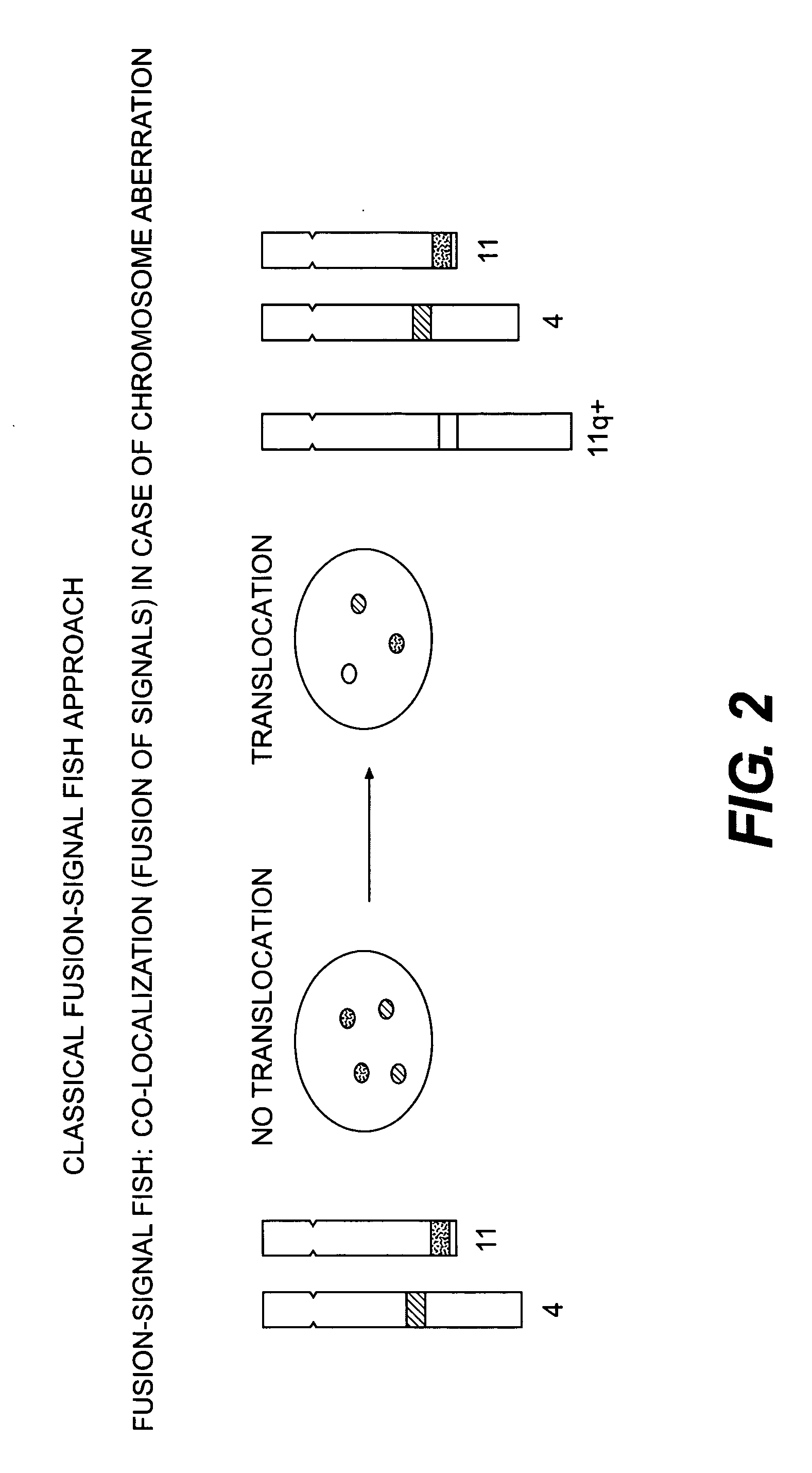Methods for detecting chromosome aberrations
- Summary
- Abstract
- Description
- Claims
- Application Information
AI Technical Summary
Benefits of technology
Problems solved by technology
Method used
Image
Examples
example 1
[0085] A slide containing metaphase spreads and interphase nuclei was pretreated in TBS (50 mmol / L Tris, 150 mmol / L NaCl, pH 7.6) with 3.7% formaldehyde for 2 minutes at room temperature, as described in Human Cytogenetics, a Practical Approach, Volume 1, 2nd ed., D. E. Rooney and B. H. Czepulkowski editors (1992). The slide was then rinsed twice in phosphate buffered saline (PBS) for 5 minutes per wash at room temperature. After rinsing, the slide was dehydrated in a cold (4° C.) series of ethanol by incubating the slide in 70% ethanol at 4° C. for 2 minutes; incubating the slide in 85% ethanol at 4° C. for 2 minutes; and then incubating the slide in 96% ethanol at 4° C. for 2 minutes, followed by air drying.
[0086] On each target area, 10 μL of DNA Hybridization Buffer (100 ng fluorescein labelled probe, 100 ng Texas Red labelled probe, 5 μM PNA Oligo Mix, 45% formamide, 300 mM NaCl, 5 mM NaPO4, 10% Dextran sulphate) was added and an 18×18 mm coverslip was applied to cover the hyb...
example 2
[0089] Slides containing metaphase spreads and interphase nuclei from normal cells and test sample cells are pretreated in TBS as described above. The slides are then rinsed twice in PBS for 5 minutes per wash at room temperature. After rinsing, the slide are dehydrated in a cold (4° C.) series of 70%, 85%, and 96% ethanol as described above, followed by air drying.
[0090] On each target area, 10 μL of DNA Hybridization Buffer (100 ng fluorescein labeled probe, 100 ng Texas Red labeled probe, 100 ng AMCA (7-amino-4-methylcoumarin-3-acitic acid) labeled probe, 5 μM PNA Oligo Mix, 45% formamide, 300 mM NaCl, 5 mM NaPO4, 10% Dextran sulphate) is added and an 18×18 mm coverslip is applied to cover the hybridization area on the slides. The edges of the coverslip are sealed with rubber cement before denaturation at 82° C. for 5 minutes. The slides are hybridized overnight at 45° C. After hybridization, the coverslip is removed and the slides are washed for 10 minutes in a stringent wash b...
example 3
[0093] PDGFRA probes were hybridized to metaphase chromosomes from metaphase spreads from normal tissue and from the cell line ELO-1. A normal PDGFRA locus on chromosome 4 was detected in normal cells as either a yellow dot or by co-localized green / red signals due to the juxtaposition of the red probes and green probes hybridizing to regions upstream and downstream from an anticipated disease-related change in chromosomal structure. An additional chromosome 4 was also detected as a result of an amplification of the derivative chromosome 4.
PUM
| Property | Measurement | Unit |
|---|---|---|
| Color | aaaaa | aaaaa |
| Structure | aaaaa | aaaaa |
| Chemiluminescence | aaaaa | aaaaa |
Abstract
Description
Claims
Application Information
 Login to View More
Login to View More - R&D
- Intellectual Property
- Life Sciences
- Materials
- Tech Scout
- Unparalleled Data Quality
- Higher Quality Content
- 60% Fewer Hallucinations
Browse by: Latest US Patents, China's latest patents, Technical Efficacy Thesaurus, Application Domain, Technology Topic, Popular Technical Reports.
© 2025 PatSnap. All rights reserved.Legal|Privacy policy|Modern Slavery Act Transparency Statement|Sitemap|About US| Contact US: help@patsnap.com



